绿色北京
北京天坛公园亲近大自然的绿色世界
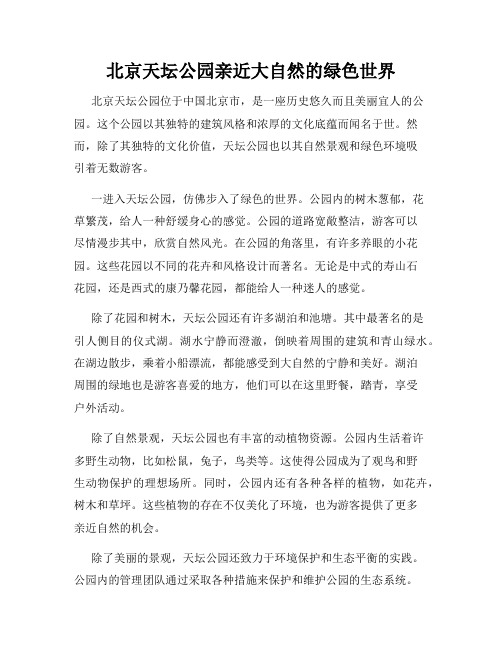
北京天坛公园亲近大自然的绿色世界北京天坛公园位于中国北京市,是一座历史悠久而且美丽宜人的公园。
这个公园以其独特的建筑风格和浓厚的文化底蕴而闻名于世。
然而,除了其独特的文化价值,天坛公园也以其自然景观和绿色环境吸引着无数游客。
一进入天坛公园,仿佛步入了绿色的世界。
公园内的树木葱郁,花草繁茂,给人一种舒缓身心的感觉。
公园的道路宽敞整洁,游客可以尽情漫步其中,欣赏自然风光。
在公园的角落里,有许多养眼的小花园。
这些花园以不同的花卉和风格设计而著名。
无论是中式的寿山石花园,还是西式的康乃馨花园,都能给人一种迷人的感觉。
除了花园和树木,天坛公园还有许多湖泊和池塘。
其中最著名的是引人侧目的仪式湖。
湖水宁静而澄澈,倒映着周围的建筑和青山绿水。
在湖边散步,乘着小船漂流,都能感受到大自然的宁静和美好。
湖泊周围的绿地也是游客喜爱的地方,他们可以在这里野餐,踏青,享受户外活动。
除了自然景观,天坛公园也有丰富的动植物资源。
公园内生活着许多野生动物,比如松鼠,兔子,鸟类等。
这使得公园成为了观鸟和野生动物保护的理想场所。
同时,公园内还有各种各样的植物,如花卉,树木和草坪。
这些植物的存在不仅美化了环境,也为游客提供了更多亲近自然的机会。
除了美丽的景观,天坛公园还致力于环境保护和生态平衡的实践。
公园内的管理团队通过采取各种措施来保护和维护公园的生态系统。
他们严格限制了游客对植物和动物的干扰,并积极开展植树活动。
公园内的垃圾回收系统和环保教育也是他们致力于环境保护的一部分。
总的来说,北京天坛公园是一个让人亲近大自然的绿色世界。
在这个公园里,游客可以逃离都市的喧嚣,享受大自然的美妙。
无论是湖泊,花园,还是野生动物和植物,都让人留连忘返。
我们应该珍惜这个绿色宝地,并为保护环境出一份力,让天坛公园成为我们子孙后代也能亲近的绿色世界。
绿色奥运,绿色北京

绿色奥运,绿色北京文采玮近来托泉一些新开美的m区遍地都是不许^内的绿肫i量是绿惹盎然j然而烈8当空2际?^们龉乎弪蠢。
怀蛊那瞿娑的硼硝,是种草还是植树l n沙炎.『f已成山巾闻的心悛之患.虻j e址J蚓q比厅地R属世界旧ki’巾接I^2的t I I哑沙蒜{五的一i}|;什,j c血:『f僚远l t捣京城。
^l然沙乍擗啦州缸泉北打地K n。
耻H}迁节连林”川涉种巷、植坩造林抒洲,l。
地舵泄f t&良牧草遏制尊均世化2叫j X城凡也H紧急衍动起采.I州一-l作战.侏J,北泉.佩H ‘11f1_】。
^部的沙小肄、空气坷染}fi 物E辩等,L忐环境¨题LO I起北求㈣政府膻巾忆的埘j-.诈把绿化l。
怍作为啦盘环境建设的重蛭H}成郝;}推l:||甩。
提瞳绿化.人”l尤疑盒恕j_l』恤‘荆。
耶幺芷种尊&F.迕址敞树曷.谜成琦r H民与政肝l’}紫m心★的l^题。
现难新迪的埘l屯小【x:九酃·R挑r环境绿化,捌木他々孙褂小少绿化听{j{!地求地火.这埘救*柑【t的q:}^环境的礁起rm凡作川。
俺整巾水足的盛,n雌矩化n:档体l女计宦排』:九科学竹-1,谯川"。
“靠近居民宙』、册地打种钕埘傩埘等高大开未.起枷树曲矮小小会给胼K带柬f1幺箍三响.什『。
q‘Ji K一岛J.祧会遮m托M,岂小f}j e r屏K的。
阳地枉”’j“审’(权”?如夸,城医与居民小lx:柯小巾城f”’1均或中心f E吲,址-¨K体闲蛙乐的奸击处。
但这蚌』场他卜d艰大多种的却址揆科棚低矮的濉水性草,啦址,m止的州Ⅱ..再水。
觚争嶷火酷q.正扯九此休魍,il I;动。
妊树虽然一岛凡.似n斗引叶{=l f且暑索塔嘭.技泉长”讯胍.缺乏遮阴乘凉的功能。
心泼m近“的似氍种植止匕斯人的酬I I l}甘,遮样刊盛夏陆*,人…就可m k槲I:_乘凉休闹,开¨嘲揪f、桃套擎,多幺惬意。
行求.是种卓迁是恤树.∞l l蹦地制“『n】为。
北京的城市绿色出行方式有哪些
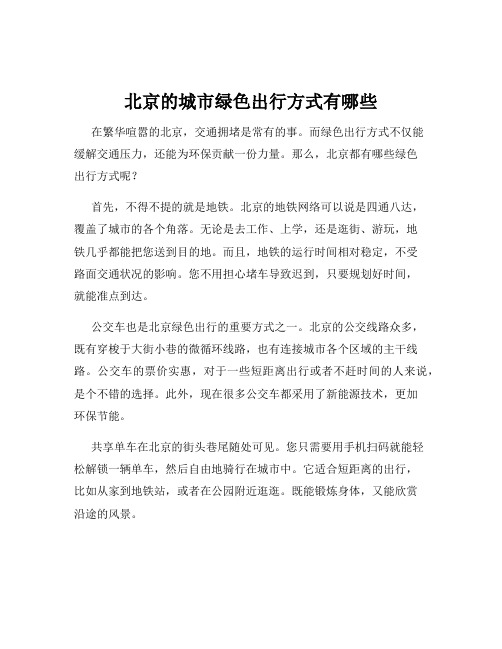
北京的城市绿色出行方式有哪些在繁华喧嚣的北京,交通拥堵是常有的事。
而绿色出行方式不仅能缓解交通压力,还能为环保贡献一份力量。
那么,北京都有哪些绿色出行方式呢?首先,不得不提的就是地铁。
北京的地铁网络可以说是四通八达,覆盖了城市的各个角落。
无论是去工作、上学,还是逛街、游玩,地铁几乎都能把您送到目的地。
而且,地铁的运行时间相对稳定,不受路面交通状况的影响。
您不用担心堵车导致迟到,只要规划好时间,就能准点到达。
公交车也是北京绿色出行的重要方式之一。
北京的公交线路众多,既有穿梭于大街小巷的微循环线路,也有连接城市各个区域的主干线路。
公交车的票价实惠,对于一些短距离出行或者不赶时间的人来说,是个不错的选择。
此外,现在很多公交车都采用了新能源技术,更加环保节能。
共享单车在北京的街头巷尾随处可见。
您只需要用手机扫码就能轻松解锁一辆单车,然后自由地骑行在城市中。
它适合短距离的出行,比如从家到地铁站,或者在公园附近逛逛。
既能锻炼身体,又能欣赏沿途的风景。
还有一种绿色出行方式就是步行。
别小看步行,它不仅零排放,还能让您更亲近这座城市。
在北京的胡同里漫步,感受老北京的韵味;在公园里散步,呼吸新鲜空气,都是非常惬意的事情。
对于那些距离稍远的出行,电动自行车是个很好的选择。
它比传统自行车速度更快,又比汽车更加灵活和节能。
只要给电池充好电,就能轻松上路。
除了以上常见的绿色出行方式,北京还在不断推广和完善其他形式的绿色交通。
比如,共享汽车正在逐渐普及。
共享汽车通常是新能源车辆,使用起来方便快捷,适合那些需要临时用车但又不想购买私家车的人。
另外,北京也在建设更多的自行车专用道,为骑行者提供更安全、舒适的出行环境。
一些区域还设置了专门的步行街区,鼓励人们步行出行。
总之,北京为市民提供了丰富多样的绿色出行方式。
每一种方式都有其独特的优势和适用场景。
选择绿色出行,不仅能够减少环境污染,降低能源消耗,还能让我们的城市更加宜居、更加美好。
北京的绿色实践

其海上风能 、海藻能源等的开发利用和光伏材料研发均
居 世界领 先 水 平 。
系 :绿色生产体系 、绿色消费体系 、生态环境建设。绿
色生产体系就是高端产业 、清洁生产 ,淘汰落后产能 ;
绿色消费体系包括绿色政务 、绿色商务 、绿色生活;生 态环境体系在碳排放方面 ,是保证未来几年大幅减少单
益 ,向世人展 示了点 “ 绿”成金 的奇迹 。
环保产业
发展惊人 。1 9 年 ,德国环 保产 业产值3 3 美元 94 3亿
占当年 G 的 1 % ,从 业 人 员 1 .万 , 占总 就 业 人 口 DP . 2 71
的04 %,产值年增长率 为1 .%( .8 03 当年G 增 长率为 DP
欧 洲 的4 %;潮汐 能和 波 浪能 资 源也 很 丰 富 。总体 上 , 0
2 0 年 北京 考虑 申办奥 运时 率先提 出 “ 00 绿色奥 运”等三大理念。2 0年奥运会 、残奥会的成功举办 , 08 向全世界展现了绿色发展的理念和实践。同年,北京正 式提 出三大定位 :绿色北京 、人文北京 、科技北京 。 2 0 年 1 月 ,北京公布了2 1年的 “ 09 2 02 绿色北京行 动计划”,首次将北京定位为2 2年初步建成 “ 00 绿色现
半。
德 国可再 生能 源发 电量 将于2 l K 底达 到总 耗 0o 电量 的1 %,未来 目标是于2 2 年达2 %,2 3 年达 4 00 7 00 4 %。在环保方面的专利份 额德国最高 ,目前 占全世界 5
环保 专利 的2 %以上 。 0 摘 自2 1 年8 7日 《 汇报 》 0 0 月1 文
北京垃圾分类处理(完整版)资料
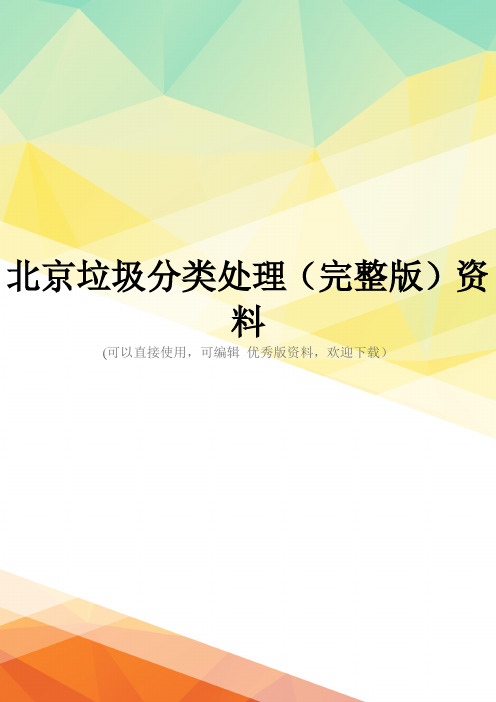
北京垃圾分类处理(完整版)资料(可以直接使用,可编辑优秀版资料,欢迎下载)全面推进生活垃圾处理和资源循环利用工作(北京市市政市容管理委员会)北京奥运会后,为巩固和扩大奥运成果,全面推进建设“人文北京、科技北京、绿色北京”的战略目标,北京市委、市政府高度重视生活垃圾处理工作,把全面推进生活垃圾处理工作作为“保增长、保民生、保稳定”的重要举措以及贯彻落实科学发展观的重要体现。
2009年4月28日市委、市政府向社会公开发布了《关于全面推进生活垃圾处理工作的意见》,明确提出:生活垃圾处理是城市管理和公共服务的重要组成部分,是改善城乡生态环境、保障城市安全运行、实现首都经济社会可持续发展的重要内容,是关系民生的基础性公益事业。
市委、市政府围绕大力推进人文北京、科技北京、绿色北京建设,立足首善之区的要求,以建设生态、循环、可持续的垃圾处理系统为宗旨,遵循减量化、资源化、无害化原则,确定了“一个定位、两个体系、三个目标、四个优先”的工作思路,“一个定位”即生活垃圾处理是关系民生的基础公益事业。
“两个体系”即着力构建城乡统筹、结构合理、技术先进、能力充足的生活垃圾处理体系和政府主导、社会参与、市级统筹、属地负责的生活垃圾管理体系。
“三个目标”即“增能力、调结构、促减量”。
“四个优先”即优先安排生活垃圾处理设施规划建设,优先采用垃圾焚烧、综合处理和餐厨垃圾资源化技术,优先推进生活垃圾源头减量,优先保障生活垃圾治理投入。
通过组织保障和目标管理,分年度实现“增能力、调结构、促减量”的工作目标:1.增加处理能力。
2021年日处理生活垃圾达到1.7万吨,基本实现餐厨垃圾分类收集和资源化处理;2021年形成日处理近3万吨的能力,满足全市生活垃圾处理需要。
提前做好规划选址工作,落实垃圾处理设施建设项目,满足今后可持续发展需要。
2.调整处理结构。
根据垃圾的成分,选择适合的垃圾处理方式。
当前我市应当积极推进生活垃圾焚烧处理,按照垃圾成分、产生量和设施建设规划,2021年垃圾焚烧、生化处理和填埋比例为2:3:5,实现城区原生垃圾零填埋;2021年比例为4:3:3,基本满足不同成分垃圾处理的需要,实现全市原生垃圾零填埋。
《北京市绿色发展指标体系》指标参考值

一、概述北京市作为我国的首都和政治、文化中心,一直以来都受到人们的关注。
随着社会经济的不断发展,环境保护和绿色发展问题日益受到人们的关注。
北京市政府也在积极推动绿色发展,为此制定了一系列的绿色发展指标体系,以实现可持续发展的目标。
本文将对北京市绿色发展指标体系的指标参考值进行详细介绍,以期为推动北京市的绿色发展提供科学依据。
二、空气质量1. PM2.5浓度根据国家环保部门的要求,PM2.5浓度在24小时内不得超过35微克/立方米,年均值不得超过15微克/立方米。
而北京市绿色发展指标体系中对PM2.5浓度的参考值要求更加严格,将24小时内的限值控制在30微克/立方米以下,年均值在12微克/立方米以下。
2. PM10浓度同样受到严格控制,24小时内限值不得超过70微克/立方米,年均值不得超过40微克/立方米。
而北京市绿色发展指标体系对PM10浓度的要求也在更严格的范围内,将24小时内的限值控制在60微克/立方米以下,年均值在30微克/立方米以下。
三、水质1. 饮用水水质北京市对饮用水的水质要求非常严格,要求符合GB5749-2006《饮用自来水卫生标准》的相关规定。
其中,总大肠菌裙不得检出,氨氮不得超过0.5毫克/升,铅含量不得超过0.01毫克/升等。
2. 地表水质量地表水分类标准分为Ⅰ、Ⅱ、Ⅲ、Ⅳ、Ⅴ五类,北京市要求地表水质量等级不低于Ⅳ类标准。
四、固体废弃物处理1. 城市生活垃圾处理率北京市绿色发展指标体系要求城市生活垃圾处理率在95以上,实现生活垃圾资源化利用。
2. 工业固体废物处理合格率工业固体废物处理合格率要求在90以上,实现工业固体废物的安全处理和资源化利用。
五、绿色能源利用1. 可再生能源利用比重北京市鼓励可再生能源的利用,要求可再生能源占能源消费比重达到15以上。
2. 低碳能源消费比重北京市要求低碳能源消费比重达到30以上,促进清洁能源的利用。
六、生态建设1. 绿地覆盖率北京市绿色发展指标体系要求绿地覆盖率不低于50,促进城市绿化和生态环境改善。
绿色北京英语作文范文
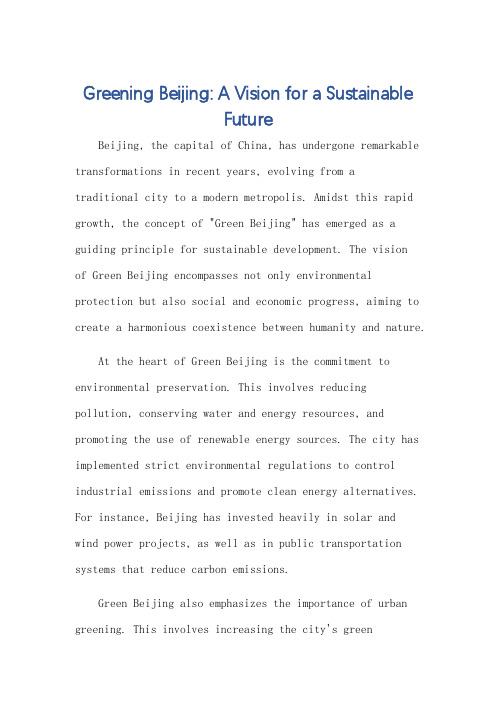
Greening Beijing: A Vision for a SustainableFutureBeijing, the capital of China, has undergone remarkable transformations in recent years, evolving from atraditional city to a modern metropolis. Amidst this rapid growth, the concept of "Green Beijing" has emerged as a guiding principle for sustainable development. The visionof Green Beijing encompasses not only environmental protection but also social and economic progress, aiming to create a harmonious coexistence between humanity and nature. At the heart of Green Beijing is the commitment to environmental preservation. This involves reducing pollution, conserving water and energy resources, and promoting the use of renewable energy sources. The city has implemented strict environmental regulations to control industrial emissions and promote clean energy alternatives. For instance, Beijing has invested heavily in solar andwind power projects, as well as in public transportation systems that reduce carbon emissions.Green Beijing also emphasizes the importance of urban greening. This involves increasing the city's greencoverage, such as parks, gardens, and tree-lined streets. These green spaces not only improve the city's aesthetics but also contribute to air quality improvement and climate regulation. Beijing has set aside significant land for parks and gardens, and has also encouraged residents to plant trees and engage in other forms of greening activities.Moreover, Green Beijing promotes sustainable living practices among its residents. This includes promoting recycling, reducing waste, and conserving water. The city has implemented waste sorting programs in schools, offices, and residential areas, educating its citizens on the importance of reducing, reusing, and recycling waste. Additionally, Beijing has installed water-saving fixtures in public and private buildings to encourage water conservation.The benefits of Green Beijing are numerous. Environmentally, the city's commitment to sustainability has led to improved air quality, reduced pollution levels, and a more habitable urban environment. Socially, Green Beijing has fostered a sense of community among residents,as they work together to improve their city's environment. Economically, the transition to clean energy and sustainable practices has created new job opportunities and spurred innovation in green technologies.In conclusion, Green Beijing represents a vision for a sustainable future that prioritizes environmental protection, social harmony, and economic prosperity. By embracing green practices and fostering a culture of sustainability, Beijing is paving the way for a brighter, more environmentally friendly future. Its commitment to Green Beijing is a model that other cities and nations can emulate in their own efforts to achieve sustainable development.**绿化北京:可持续未来的愿景**北京,中国的首都,近年来经历了显著的变化,从一个传统的城市演变成为一个现代化的大都市。
北京市绿色发展指标体系

北京市绿色发展指标体系— 1 —— 2 —— 3 —注:1. 标★的为《北京城市总体规划(2016-2035年)》中资源环境相关指标和《北京市国民经济和社会发展第十三个五年规划纲要》中确定的资源环境约束性指标;标◆的为《国民经济和社会发展第十三个五年规划纲要》、《中共中央、国务院关于加快推进生态文明建设的意见》以及本市相关专项规划、工作方案等提出的主要监测评价指标;标△的为其他绿色发展重要监测指标。
一级指标权重与国家绿色发展指标体系一致,每项一级指标下,按二级指标的重要程度赋予不同权重,三类指标权重之比原则上为3:2:1,部分指标权重根据现阶段重点工作进行了适当调整。
2.绿色发展指标体系采用综合指数法进行测算,结合“十三五”规划纲要和相关部门规划目标,测算各区绿色发展指数和资源利用指数、环境治理指数、环境质量指数、生态保护指数、增长质量指数、绿色生活指数6个分类指数。
绿色发展指数由“公众满意程度”之外的38个指标个体指数加权平均而成,指数值在〔60,100〕之间。
计算公式为:i i Ni Y W Z ∑==1(N=1,2, (38)其中,Z 为绿色发展指数,i Y 为指标的个体指数,N 为指标个数,i W 为指标i Y 的权数。
绿色发展指标按评价作用分为正向指标和逆向指标,按指标数据性质分为绝对数和相对数指标。
在计算指数时,将绝对数指标转化为相对数指标,将逆向指标转化为正向指标,将总量控制指标转化成年度增长控制指标,对各个指标进行标准化处理,然后再计算个体指数。
3.公众满意度调查为主观调查指标,通过北京市统计局、国家统计局北京调查总队组织的抽样调查来反映公众对生态环境的满意程度。
调查采用分层多阶段抽样的方法,随机抽取各区城镇和乡村居民进行调查。
根据调查结果综合计算16个区的公众满意程度。
调查结果不参与总指数计算,进行单独评价,纳入生态文明建设考核目标体系。
4.绿色发展指数所需数据来自各部门的年度统计,各部门负责按时提供数据,并对数据质量负责。
北京绿色建筑评价标准
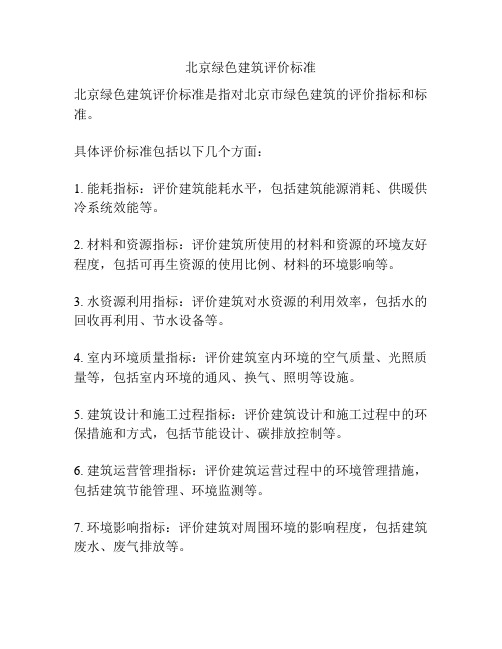
北京绿色建筑评价标准
北京绿色建筑评价标准是指对北京市绿色建筑的评价指标和标准。
具体评价标准包括以下几个方面:
1. 能耗指标:评价建筑能耗水平,包括建筑能源消耗、供暖供冷系统效能等。
2. 材料和资源指标:评价建筑所使用的材料和资源的环境友好程度,包括可再生资源的使用比例、材料的环境影响等。
3. 水资源利用指标:评价建筑对水资源的利用效率,包括水的回收再利用、节水设备等。
4. 室内环境质量指标:评价建筑室内环境的空气质量、光照质量等,包括室内环境的通风、换气、照明等设施。
5. 建筑设计和施工过程指标:评价建筑设计和施工过程中的环保措施和方式,包括节能设计、碳排放控制等。
6. 建筑运营管理指标:评价建筑运营过程中的环境管理措施,包括建筑节能管理、环境监测等。
7. 环境影响指标:评价建筑对周围环境的影响程度,包括建筑废水、废气排放等。
以上是北京绿色建筑评价的一些基本指标,具体的评价标准可以根据实际情况进行细化和调整。
北京市人民政府关于印发《北京市“十四五”时期生态环境保护规划》的通知
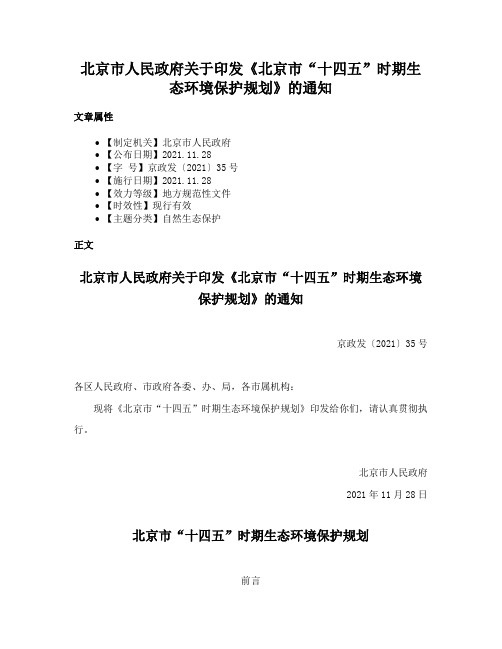
北京市人民政府关于印发《北京市“十四五”时期生态环境保护规划》的通知文章属性•【制定机关】北京市人民政府•【公布日期】2021.11.28•【字号】京政发〔2021〕35号•【施行日期】2021.11.28•【效力等级】地方规范性文件•【时效性】现行有效•【主题分类】自然生态保护正文北京市人民政府关于印发《北京市“十四五”时期生态环境保护规划》的通知京政发〔2021〕35号各区人民政府、市政府各委、办、局,各市属机构:现将《北京市“十四五”时期生态环境保护规划》印发给你们,请认真贯彻执行。
北京市人民政府2021年11月28日北京市“十四五”时期生态环境保护规划前言“十四五”时期是我国在全面建成小康社会、实现第一个百年奋斗目标之后,乘势而上开启全面建设社会主义现代化国家新征程、向第二个百年奋斗目标进军的第一个五年,也是北京落实首都城市战略定位、建设国际一流的和谐宜居之都的关键时期,做好生态环境保护工作意义重大。
要深入贯彻习近平生态文明思想,深入实施绿色北京战略,加快推进碳减排碳中和,深入打好污染防治攻坚战,着力提升生态系统质量和稳定性,协同推进经济高质量发展和生态环境高水平保护。
本规划主要依据生态环境保护法律法规、《北京城市总体规划(2016年—2035年)》《北京市国民经济和社会发展第十四个五年规划和二〇三五年远景目标纲要》等编制。
一、新发展阶段生态环境保护新要求(一)“十三五”时期生态环境保护成效卓著“十三五”时期,是全市生态环境保护战线广泛、措施综合、治理系统、成效最明显的五年,生态环境保护重视程度之高、污染防治攻坚力度之大、区域协同治污合力之强、生态环境质量改善速度之快前所未有。
五年来,全市深入贯彻落实习近平生态文明思想和习近平总书记对北京重要讲话精神,牢固树立“绿水青山就是金山银山”的理念,切实加大生态环境保护力度,生态环境质量持续大幅改善,“十三五”规划目标提前超额完成,人民群众生态环境获得感、幸福感、安全感显著增强,北京大气污染防治经验被联合国环境署纳入实践案例。
建设“人文北京、科技北京、绿色北京”
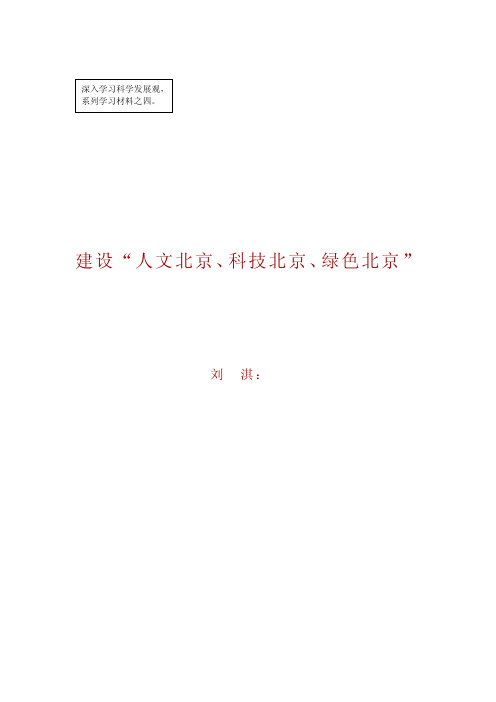
建设“人文北京、科技北京、绿色北京”刘淇:在党中央、国务院的坚强领导下,在全国人民的大力支持下,在国际奥委会、国际残奥委会和相关国际组织的积极帮助下,北京奥运会、残奥会取得了圆满成功。
坚持贯彻“绿色奥运、科技奥运、人文奥运”的理念,是北京奥运会、残奥会成功举办的关键,也是贯彻落实科学发展观的具体体现和生动实践。
认真总结奥运会、残奥会的成功经验,按照首都工作的特点和规律,不断丰富、升华、发展人文、科技、绿色三大理念,努力建设“人文北京、科技北京、绿色北京”,必将有力推动首都经济社会又好又快发展。
一20世纪90年代末,党中央、国务院做出申办2008年奥运会的重大决策。
2000年初,北京奥申委根据中央的指示,在集中有关专家和广大群众智慧的基础上提出了“新北京,新奥运”的申办口号和“绿色奥运、科技奥运、人文奥运”的申办理念,并在2001年1月将其正式写入了《申办报告》。
申办口号和三大理念集中表达了北京奥运会的特色,阐明了举办奥运会与促进我国经济社会科学发展的高度一致性。
绿色奥运的理念萌生于奥林匹克运动对自身可持续发展的探索,具体实践始于2000年悉尼奥运会。
北京奥运会借鉴往届奥运会的成功经验,把繁荣奥林匹克运动与党中央关于建设生态文明、实现可持续发展的伟大号召,与首都加强生态环境建设、建设宜居城市的战略目标紧密结合起来,通过制定严格的生态环境标准和保障制度,全面推进环境治理和环境保护,广泛开展环境教育,使“绿色奥运”理念在思想深度和实践广度上实现了前所未有的飞跃。
科技进步是奥林匹克运动发展的重要动力。
北京奥运会从实施科教兴国战略、提高国家自主创新能力的高度出发,明确提出将“科技奥运”作为指导奥运筹办工作的重要理念。
通过以科学精神引领奥运、以科学技术支撑奥运、以科技奥运惠及社会这三个层面的丰富实践,在举办一届荟萃人类最新科技成果的奥运盛会的同时,全面推动我国科学技术的跨越式发展。
人文精神是奥林匹克运动的核心。
北京在绿色发展方面的问题

北京在绿色发展方面的问题一、引言北京是中国的首都,也是一个国际化大都市,经济、文化等方面发展迅速。
但随着城市化进程的加快,环境污染、资源消耗等问题也日益突出。
为了实现可持续发展,北京开始注重绿色发展。
二、背景北京作为一个大城市,其环境问题一直备受关注。
据统计,2019年北京市PM2.5浓度同比下降9.3%。
但仍然存在诸多环境问题,如交通拥堵、噪音污染等。
三、绿色发展的意义1.保护生态环境:绿色发展可以减少对自然资源的消耗和对生态环境的破坏。
2.提高城市品质:绿色发展可以改善城市环境质量,提高居民生活品质。
3.促进经济发展:绿色产业具有较高的技术含量和附加值,可以促进经济转型升级。
四、存在的问题1.能源结构不合理:目前北京仍然依赖传统能源如煤电来满足能源需求。
2.交通拥堵严重:由于私家车数量过多,城市交通拥堵严重,导致空气污染问题日益突出。
3.缺乏绿色基础设施:虽然北京已经建设了一些绿色基础设施如公园、自行车道等,但仍然存在不足。
五、解决方案1.推进能源转型:加快推进清洁能源的开发和利用,减少对传统能源的依赖。
2.控制车辆数量:限制私家车的增长,鼓励公共交通工具的使用。
3.加强绿化建设:提高城市绿化覆盖率,建设更多的公园和绿地。
六、案例分析1.北京地铁:北京地铁是一个优秀的绿色交通系统。
它减少了私家车使用量,降低了空气污染和噪音污染。
2.朝阳区CBD:朝阳区CBD是一个典型的现代化商业中心。
它采用了节能环保技术,并注重生态环境保护。
七、总结北京在绿色发展方面取得了一定成绩,但仍然存在诸多问题。
只有通过加强政策引导和技术创新等手段,才能实现可持续发展。
我们应该共同努力,为绿色北京做出贡献。
绿色北京英语作文范文

绿色北京英语作文范文In the heart of China, nestled within the historical and cultural richness of the capital city, lies a vision of a greener future – Green Beijing. This vision encapsulates the aspirations of a city that strives to harmonize with nature, while preserving its rich heritage and推进economic progress. Green Beijing is not just a slogan or a trend; it's a commitment to sustainable development, environmental protection, and social well-being.The landscape of Green Beijing is painted with apalette of lush greenery, clean streets, and vibrant public spaces. Trees and plants dot the urban landscape, providing a cooling shade in the summer heat and absorbing carbon dioxide, thus contributing to the mitigation of climate change. Green spaces like parks and gardens offer citizens a respite from the hustle and bustle of city life, promoting physical and mental health.The transportation system of Green Beijingprioritizes non-polluting modes like cycling and public transportation. Electric vehicles and hybrid technologies are encouraged, reducing the carbon footprint of the city. This shifttowards a low-carbon economy not only benefits the environment but also contributes to improving air quality, a crucial aspect of urban life.Green buildings and sustainable construction practices are at the forefront of Green Beijing's urban planning. These buildings are designed to conserve energy, use renewable resources, and create a healthy indoor environment. This approach not only reduces the city's carbon emissions but also lowers energy costs for residents and businesses.Green Beijing also emphasizes waste reduction and recycling. With a focus on waste segregation and proper disposal, the city aims to minimize its waste footprint. Initiatives like composting organic waste and recycling plastics are encouraged, promoting a circular economy where resources are used efficiently and waste is minimized.Moreover, Green Beijing is inclusive, welcoming all its residents to participate in its greening efforts. Community gardens, school environmental clubs, and public awareness campaigns are just some of the ways the city encourages citizen engagement. These activities not only educatepeople about the importance of sustainability but also foster a sense of responsibility and ownership towards protecting the environment.The journey towards Green Beijing isongoing, but the city has already made significant progress. With a clear vision and committed leadership, Green Beijing is becoming a reality, setting an example for other cities in China and beyond to follow. The future of Green Beijing is bright, filled with promise and hope for a more sustainable and harmonious urban life.**绿色北京:可持续发展的愿景**在中国的心脏地带,首都城市的历史文化丰富性中,隐藏着一个绿色未来的愿景——绿色北京。
北京卷英语绿色北京作文范文

北京卷英语绿色北京作文范文A Model for Sustainable Urban Development":Beijing, the capital city of China, has long been recognized as a global center of political, economic, and cultural influence. However, in recent years, the city has also gained attention for its efforts in promoting sustainable urban development and environmental protection. The concept of "Green Beijing" has emerged as a guiding principle for the city's development, with a focus on integrating ecological preservation, renewable energy, and green infrastructure into the urban landscape.At the heart of the Green Beijing initiative is a commitment to reducing the city's carbon footprint and mitigating the effects of climate change. The municipal government has implemented a range of policies and initiatives aimed at promoting energy efficiency, renewable energy, and sustainable transportation. This includes the expansion of the city's metro system, the introduction of electric vehicles, and the development of smart grid technology to optimize energy distribution and consumption.One of the most visible aspects of Green Beijing is the city'sextensive network of parks, gardens, and green spaces. The city boasts over 200 parks, covering an area of more than 4,000 square kilometers. These green spaces not only provide recreational opportunities for residents and visitors but also play a crucial role in regulating the local climate, improving air quality, and enhancing biodiversity.The Beijing Municipal Government has also made significant investments in the development of green buildings and sustainable infrastructure. New construction projects are required to meet stringent energy efficiency standards, and the city has introduced incentives for the retrofitting of existing buildings to improve their environmental performance. Additionally, the city has invested heavily in the development of renewable energy sources, such as solar and wind power, to reduce its reliance on fossil fuels.One of the most innovative aspects of Green Beijing is the city's approach to urban planning and design. The municipal government has embraced the concept of "sponge city" development, which aims to integrate natural water management systems into the urban landscape. This includes the creation of permeable surfaces, the construction of detention ponds and wetlands, and the implementation of green roofs and vertical gardens. These measures not only help to mitigate the risk of flooding but also contribute to the city's overall sustainability by reducing the demand for waterresources and improving the local ecosystem.The success of the Green Beijing initiative can be seen in the city's improved air quality and reduced carbon emissions. In recent years, the city has experienced a significant decline in the levels of particulate matter and other pollutants, thanks to the implementation of strict air quality control measures and the promotion of clean energy sources. Additionally, the city's efforts to promote sustainable transportation and reduce energy consumption have resulted in a decrease in greenhouse gas emissions, contributing to the global fight against climate change.However, the journey towards a truly sustainable Beijing is not without its challenges. The city's rapid urbanization and population growth have placed significant strain on its natural resources and infrastructure, and the municipal government must continue to invest in innovative solutions to address these issues. Additionally, the city must work to engage with its citizens and foster a culture of environmental stewardship, encouraging individuals and communities to adopt sustainable practices in their daily lives.Despite these challenges, the Green Beijing initiative serves as a model for sustainable urban development, demonstrating how a city can balance economic growth, environmental protection, and social well-being. The city's commitment to innovation, collaboration, andlong-term planning has positioned it as a global leader in the field of sustainable urban development, inspiring other cities around the world to follow in its footsteps.In conclusion, the Green Beijing initiative is a testament to the power of bold vision, strategic planning, and collaborative action. By integrating ecological preservation, renewable energy, and green infrastructure into the urban landscape, Beijing has not only improved the quality of life for its residents but also set an example for sustainable urban development that can be replicated in cities around the world. As the world continues to grapple with the challenges of climate change and environmental degradation, the story of Green Beijing serves as a reminder that with the right approach, cities can become part of the solution rather than the problem.。
坚持高端一流标准 建设绿色北京示范区——访北京市延庆县市政市容委主任鲁世宽

考核评价 办法 》 ,落 实考核任 务 。通过
加 强环境 管理 ,提高环境 管理 能效 ,城
乡环境管 理更加 有力 、更加规 范 ,县域 整体环境 质量 、镇村环境 意识 均有 了明
显提 升。
观 ,有利 的促进 了产业 发展 。
的环 境互动 平 台 ,及 时通报 了情 况 ,听
记者 :谢谢 鲁主任 。
庆的城 市公 用设施 更全 了 ,服 务能 力更 告等 系列整治 行动 ,净化 市容秩 序。通 在规 划实施 中 。通 过几年 的建设 ,极大 强 了 ,承载 能 力明显提 升 了。这 是延 庆 过大 整治 ,消灭 了一批卫 生死 角 ,城 乡 的提 升 了大 环 境 建 设 档 次 ,丰 富 了景
为 主 要整 治 区域 , “ 乱 ”是 以 “ 倒 探索 ,我 们总 结 出了 “ 清 、拆 、整 、 3 乱
推进精细化管理 构 建宜居新城
垃圾 、乱 堆乱放 、私 搭乱建 ”为重 点整 联 、绿 、理 、精 、美、特 、全 ”的 环境
治内容 ;落责任 ——对 全县卫 生责任 区 建设十 字方针 ,并积 极用于指 导实践 。
荣誉称号 。2 0 年6 ,延 庆被 确 定为全 国生态 文明建 设 试点县 ,生 09 月 态文明建设瞄 准 了更高的 目标 。 按 “ 十二五 ”规划 发展 的 总体 目标 定位 ,建 设 “ 色北京示 范 绿 区” 已成 为延庆贯彻 落实科 学发展观 、实现 经济社会 又好 又快 发展 的
绿色北京为主题的社团活动英语作文
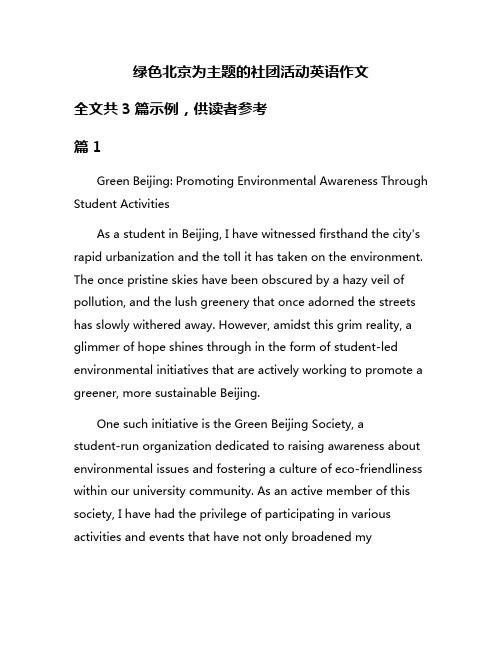
绿色北京为主题的社团活动英语作文全文共3篇示例,供读者参考篇1Green Beijing: Promoting Environmental Awareness Through Student ActivitiesAs a student in Beijing, I have witnessed firsthand the city's rapid urbanization and the toll it has taken on the environment. The once pristine skies have been obscured by a hazy veil of pollution, and the lush greenery that once adorned the streets has slowly withered away. However, amidst this grim reality, a glimmer of hope shines through in the form of student-led environmental initiatives that are actively working to promote a greener, more sustainable Beijing.One such initiative is the Green Beijing Society, astudent-run organization dedicated to raising awareness about environmental issues and fostering a culture of eco-friendliness within our university community. As an active member of this society, I have had the privilege of participating in various activities and events that have not only broadened myunderstanding of environmental challenges but also inspired me to take action.One of our most notable endeavors was the "Reduce, Reuse, Recycle" campaign, which aimed to educate students on the importance of proper waste management and resource conservation. We organized workshops and seminars where experts from various fields shared their insights on sustainable living practices, such as composting, upcycling, and responsible consumption. These interactive sessions provided students with practical tips and hands-on experiences, empowering them to make more environmentally conscious choices in their daily lives.Additionally, the Green Beijing Society organized campus clean-up drives, where volunteers donned gloves and armed themselves with trash bags, scouring every nook and cranny of our university grounds to collect litter. It was disheartening to see the sheer amount of waste that had accumulated, but it also served as a stark reminder of the impact our actions have on the environment. These clean-up events not only fostered a sense of community and camaraderie among participants but also instilled a sense of responsibility towards maintaining a clean and healthy campus.One of the most memorable experiences for me was our tree-planting initiative, where we collaborated with local environmental organizations to create urban green spaces within the city. Donning sturdy boots and armed with shovels, we ventured into designated areas and worked tirelessly to plant saplings, nurturing them with care and attention. It was a humbling experience to witness the transformative power of nature as these tiny seedlings took root and slowly flourished into vibrant, lush trees.Beyond these hands-on activities, the Green Beijing Society also organized thought-provoking lectures and panel discussions, inviting experts from various fields to share their insights on topics ranging from sustainable urban planning to the impact of climate change on China's environment. These events provided a platform for intellectual discourse, encouraging students to think critically and engage in constructive dialogues about environmental issues.Furthermore, we recognized the power of art in raising awareness and inspiring change. Through our "Green Art" initiative, we encouraged students to express their environmental concerns and aspirations through various artistic mediums, such as paintings, sculptures, and photography. Thesecreative expressions were then showcased in exhibitions, allowing the broader community to appreciate the beauty and fragility of our natural world while also sparking conversations about environmental conservation.As I reflect on my involvement with the Green Beijing Society, I am filled with a profound sense of gratitude and accomplishment. Through these collective efforts, we have not only raised awareness about environmental issues but also actively contributed to the greening of our city. However, our journey is far from over, and the challenges we face are daunting.Beijing, like many other rapidly developing cities, grapples with the delicate balance between economic growth and environmental sustainability. The constant influx of people and the insatiable demand for resources have put immense strain on the city's ecological systems. Air pollution, water scarcity, and waste management are just a few of the pressing issues that require immediate attention and innovative solutions.As students and future leaders, it is our responsibility to continue advocating for sustainable practices and pushing for policy changes that prioritize environmental protection. We must leverage the power of education and awareness to inspireindividuals, communities, and governments to take decisive action towards a greener, more sustainable future.The path ahead is challenging, but I remain steadfast in my belief that through collective action and unwavering determination, we can create a Beijing that not only thrives economically but also maintains a harmonious coexistence with nature. The Green Beijing Society has ignited a flame within me, a flame that burns brightly with the desire to protect and preserve our planet for generations to come.In the words of the ancient Chinese philosopher Lao Tzu, "Nature does not hurry, yet everything is accomplished." Let us embrace this wisdom and approach our environmental efforts with patience, perseverance, and a deep reverence for the natural world that sustains us. Together, we can weave a tapestry of green, where the threads of sustainability, education, and community action intertwine to create a vibrant and resilient future for Beijing and beyond.篇2A Green Adventure in BeijingAs an environmental science student, I jumped at the opportunity to join the Green Club at my university in Beijing.The club organizes various activities to promote environmental awareness and sustainable living practices. Recently, they planned an exciting eco-tour around the city, and I couldn't wait to participate.The day of the tour arrived, and our group of twenty enthusiastic members gathered at the university gates. Our first stop was the Chaoyang Park, a sprawling green oasis in the heart of Beijing's busy urban landscape. As we strolled along the winding paths, our guide, a knowledgeable botanist, pointed out various plant species and explained their ecological significance.One particular highlight was the park's butterfly garden, where we observed numerous species of these delicate creatures flitting from flower to flower. Our guide emphasized the importance of preserving habitats for pollinators, as they play a crucial role in maintaining biodiversity and ensuring food security.Next, we visited the Beijing Botanical Garden, a vast expanse showcasing an impressive collection of flora from around the world. As we wandered through the meticulously curated gardens, our guide shared insights into the conservation efforts employed to protect endangered plant species. I was particularly fascinated by the desert ecosystem section, where I learnedabout the ingenious adaptations plants have developed to survive in arid conditions.After a picnic lunch in the garden's serene surroundings, we embarked on a tour of Beijing's eco-friendly initiatives. Our first stop was a community garden, where local residents came together to cultivate their own organic produce. It was heartening to see people of all ages working side by side, nurturing the land and fostering a sense of community.We then visited a recycling facility, where we gained a deeper understanding of the importance of proper waste management. Seeing the sheer volume of recyclable materials being processed was a sobering reminder of the impact our consumption habits have on the environment. Our guide emphasized the need to adopt a more sustainable lifestyle by reducing, reusing, and recycling whenever possible.One of the highlights of our tour was a visit to a rooftop garden atop a residential building. This innovative project not only provided a green space for urban dwellers but also helped mitigate the urban heat island effect. As we strolled through the lush vegetation, our guide explained the benefits of incorporating greenery into urban planning, such as improved air quality, temperature regulation, and mental well-being.Our final stop was a solar power plant on the outskirts of Beijing. As we toured the facility, our guide explained the principles of solar energy generation and its role in transitioning towards a more sustainable future. Witnessing the vast arrays of solar panels was a testament to Beijing's commitment to embracing renewable energy sources.Throughout our eco-tour, I was struck by the level of environmental consciousness present in Beijing. From community-driven initiatives to large-scale projects, it was evident that the city was actively working towards a greener and more sustainable future. As we bid farewell to our guide, I felt a renewed sense of responsibility to do my part in protecting our planet.Upon returning to campus, our club gathered to debrief and share our experiences. We discussed the various initiatives we had witnessed and brainstormed ways to implement similar projects within our university community. Some ideas included starting a composting program, organizing campus clean-up drives, and raising awareness about sustainable living practices through educational campaigns.Looking back on our eco-tour, I realized that it was not just an enjoyable outing but a transformative experience. It openedmy eyes to the myriad ways in which we can contribute to environmental conservation, even in an urban setting like Beijing. The tour reinforced the importance of collective action and inspired me to become a more conscientious citizen.As I reflect on the day's events, I am filled with hope and determination. Beijing's efforts to embrace sustainability serve as an inspiring example for cities around the world. By fostering a deeper connection with nature and promoting eco-friendly practices, we can create a greener, healthier, and more sustainable future for generations to come.篇3Green Beijing: A Journey Towards Environmental ConsciousnessAs a student at the prestigious Beijing University, I have always been intrigued by the city's rich cultural heritage and its rapid urban development. However, one aspect that has consistently captured my attention is the university's commitment to environmental sustainability and its efforts to promote a greener Beijing. It was this passion that led me to join the Green Beijing Club, a vibrant community of like-minded individuals dedicated to raising awareness about environmentalissues and taking tangible steps towards a more sustainable future.The Green Beijing Club is a melting pot of diverse perspectives and backgrounds, united by a common goal – to create a greener, more eco-friendly campus and city. From organizing campus clean-up drives to hosting seminars on sustainable living, the club's activities are designed to engage students, faculty, and the broader community in meaningful conversations and actions.One of the club's flagship events is the annual "Green Week," a week-long celebration of all things eco-friendly. During this time, the campus is transformed into a hub of sustainability, with exhibits, workshops, and interactive installations that showcase innovative solutions to environmental challenges. Last year, I had the opportunity to participate in the "Recycled Art Exhibition," where students showcased their creative talents by repurposing discarded materials into stunning works of art. It was a powerful reminder of the potential hidden within the things we often discard.Another highlight of my involvement with the Green Beijing Club has been the opportunity to engage with local communities. Through our "Community Outreach Program," we visit schoolsand neighborhood centers, educating children and adults alike on the importance of environmental stewardship. It is truly heartwarming to witness the enthusiasm and curiosity of these individuals as they learn about simple yet impactful ways to reduce their carbon footprint and live more sustainably.One of the most rewarding experiences has been our collaboration with a local urban farm. Every weekend, a group of us volunteers at the farm, assisting with planting, harvesting, and maintaining the crops. Not only has this hands-on experience taught me valuable lessons about sustainable agriculture, but it has also fostered a deeper appreciation for the hard work and dedication required to produce the food we often take for granted.Beyond these tangible activities, the Green Beijing Club has also served as a platform for intellectual discourse and personal growth. Through panel discussions, guest lectures, and informal gatherings, we have had the opportunity to engage with experts, policymakers, and activists, broadening our understanding of the complex environmental challenges facing our city, our nation, and our planet.As I reflect on my journey with the Green Beijing Club, I am filled with a sense of pride and gratitude. Pride in being part of amovement that is actively shaping a more sustainable future, and gratitude for the invaluable lessons and experiences that have enriched my worldview and inspired me to become a more conscientious global citizen.However, our work is far from over. The road ahead is long and arduous, but I am emboldened by the unwavering dedication and passion of my fellow club members. Together, we will continue to raise awareness, inspire change, and advocate for policies and practices that prioritize the health of our planet.In the words of the renowned environmentalist Rachel Carson, "The more clearly we can focus our attention on the wonders and realities of the universe about us, the less taste we shall have for destruction." It is this sentiment that fuels our collective efforts, as we strive to create a greener, more sustainable Beijing – a city that not only celebrates its rich heritage but also embraces a future where harmony with nature is the guiding principle.As I look forward to the remainder of my academic journey and beyond, I am confident that the lessons and experiences gained through the Green Beijing Club will continue to shape my perspectives and actions. For it is not merely a club or a collection of activities, but a movement – a movement thattranscends borders and generations, uniting individuals from all walks of life in a shared pursuit of a greener, more sustainable world.。
企业信用报告_国合绿色(北京)工程技术研究院有限公司
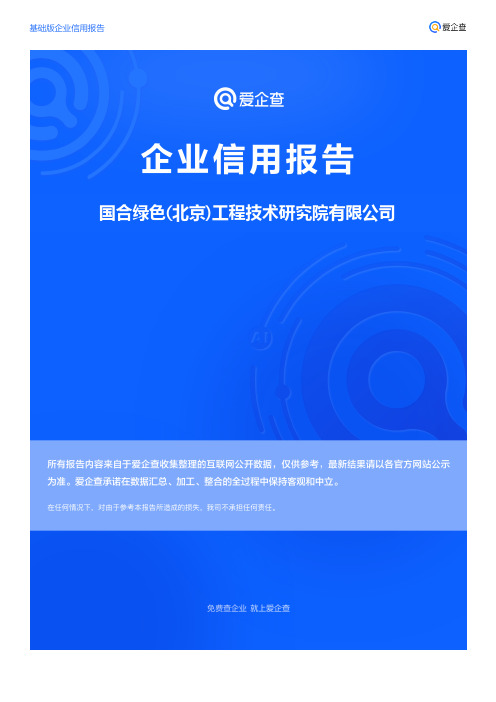
目录一、企业背景 (5)1.1 工商信息 (5)1.2 分支机构 (5)1.3 变更记录 (5)1.4 主要人员 (6)1.5 联系方式 (6)二、股东信息 (7)三、对外投资信息 (7)四、企业年报 (7)五、重点关注 (9)5.1 被执行人 (9)5.2 失信信息 (9)5.3 裁判文书 (9)5.4 法院公告 (9)5.5 行政处罚 (9)5.6 严重违法 (9)5.7 股权出质 (10)5.8 动产抵押 (10)5.9 开庭公告 (10)5.11 股权冻结 (10)5.12 清算信息 (10)5.13 公示催告 (10)六、知识产权 (10)6.1 商标信息 (11)6.2 专利信息 (11)6.3 软件著作权 (11)6.4 作品著作权 (11)6.5 网站备案 (11)七、企业发展 (11)7.1 融资信息 (11)7.2 核心成员 (11)7.3 竞品信息 (12)7.4 企业品牌项目 (12)八、经营状况 (12)8.1 招投标 (12)8.2 税务评级 (12)8.3 资质证书 (13)8.4 抽查检查 (13)8.5 进出口信用 (13)8.6 行政许可 (13)一、企业背景1.1 工商信息企业名称:国合绿色(北京)工程技术研究院有限公司工商注册号:110102023939010统一信用代码:91110102MA00H46C78法定代表人:许明群组织机构代码:MA00H46C-7企业类型:有限责任公司(自然人投资或控股)所属行业:研究和试验发展经营状态:开业注册资本:1,000万(元)注册时间:2017-08-14注册地址:北京市大兴区圣和巷8号院5号楼5层522营业期限:2017-08-14 至 2037-08-13经营范围:工程和技术研究和试验发展;水污染治理;大气污染治理;固体废物污染治理;企业管理咨询;公共关系服务;技术开发、技术推广、技术转让、技术咨询、技术服务。
(企业依法自主选择经营项目,开展经营活动;依法须经批准的项目,经相关部门批准后依批准的内容开展经营活动;不得从事本市产业政策禁止和限制类项目的经营活动。
- 1、下载文档前请自行甄别文档内容的完整性,平台不提供额外的编辑、内容补充、找答案等附加服务。
- 2、"仅部分预览"的文档,不可在线预览部分如存在完整性等问题,可反馈申请退款(可完整预览的文档不适用该条件!)。
- 3、如文档侵犯您的权益,请联系客服反馈,我们会尽快为您处理(人工客服工作时间:9:00-18:30)。
关于开展绿色北京
2013年北京市教育系统节能减排主题系列活动通知
各学校德育干部:
您好!
为贯彻国家生态文明建设发展战略,结合全国节能周的宣传和教育工作,市教委、市发展和改革委决定共同举办“绿色北京-2013年北京市教育系统节能减排主题系列活动”现将有关事项通知如下:
一、活动内容与要求
(一)节能减排创新成果征集活动
A类:节能减排征文(与节能减排相关的故事、调查报告、警示语、金点子、诗歌等),撰写模板见附件1。
B类:节能减排优秀方案征集(针对学校、家庭、社区节能减排实际问题提出的具体解决方案),撰写模板见附件2。
C类:节能减排创意作品征集(以节能减排为主题的科技小发明、漫画、废旧物品利用作品等),本次活动暂不接受实物作品,请参赛人员按照组委会相关要求撰写创意设计、作品说明并提供照片和视频等辅助材料,撰写模板见附件3。
(二)节能减排文艺作品展演
节能减排文艺作品包括体现有关节能减排,低碳环保的小品、歌曲、诗歌创作与朗诵、快板、舞蹈等多种形式。
展演分幼儿园组、小学组、中学组、大学组。
各校提供1个文艺作品,撰写模板见附件4。
二、上报时间
请各校于9月17日之前通过办公网邮件形式发送至中教一科——陈晨电话:67182864
中教一科
2013年9月10日
(征文类)征文名称
征文类别
(请在相应类别划勾)A大学组 B 中学组
C 小学组(包括幼儿园)
D 成人组(包括家庭)
作者所在区县
作者单位
指导教师(如有)
作者个人信息
姓名性别职务/职称/
年级
联系电话E-mail
征文正文(说明:①紧扣节能减排主题;体裁不限;须为原创作品,不得抄袭;5000字以内;②请以WORD文档形式投稿,题目请设置黑体,小四字号,正文为宋体、小四字号。
③组委会对获奖作品拥有除署名权外的所有著作权权利。
凡参加此次征集活动的作者即视为认同并遵守上述约定。
金点子、节能小常识、警示用语等不限字数)
(方案类)方案名称
方案类别
(请在相应类别划勾)A大学组 B 中学组C 小学组(包括幼儿园) D 成人组
参赛区县
参赛单位
指导教师(如有)
方案设计主创人员信息
姓名职务职称联系电话E-mail
一、方案背景描述(包括方案提出的现实需求、实际对问题等简要背景信息)
二、方案的目标(包括本方案拟解决问题及目标)
三、方案的功能描述(详细列出方案的主要功能、原理、技术分析等)
四、方案实现的预期效果(方案实施后应用前景)
(创意作品类)方案名称
方案类别
(请在相应类别划勾)A大学组 B 中学组C 小学组(包括幼儿园) D 成人组
参赛区县
参赛单位
指导教师(如有)
方案设计主创人员信息
姓名职务职称联系电话E-mail
一、创意背景描述(包括方案提出的现实需求、实际问题等简要背景信息)
二、创意设计的目标(包括实施该创意作品可以解决的问题)
三、创意设计的功能描述(详细列出创意设计作品的主要功能、原理、技术分析等)
四、创意设计预期效果评估(创意实施后应用前景等)
五、相关材料(实物照片、专利或获奖证明等)
附件4:2013年北京市教育系统节能减排文艺作品展演报名表
中学组团队信息
学校名称
中学组组队负责
人姓名
性别职务联系电话邮箱
作品名称作品类别作品类别一栏应填写小品、歌曲、快板、诗歌朗诵、舞蹈……
成员1姓名单位联系电话成员2姓名单位联系电话成员3姓名单位联系电话成员4姓名单位联系电话成员5姓名单位联系电话。
